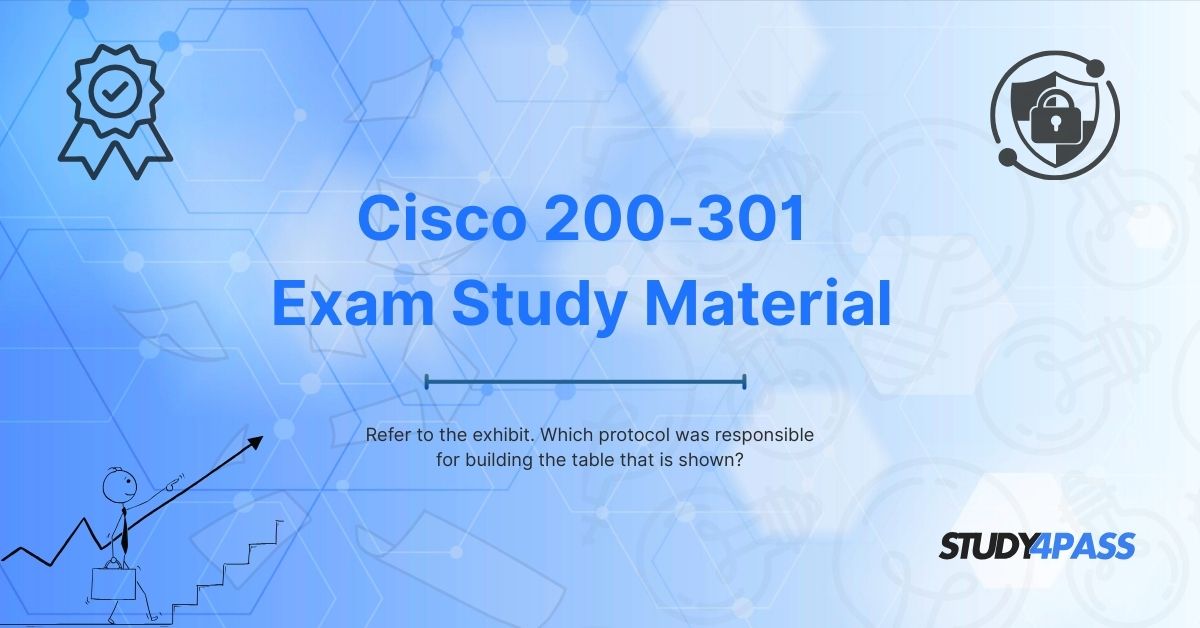Introduction
In Cisco networking exams such as CCNA (200-301), CCDA, CCENT, CCNA Security, and CCNA Wireless, understanding network protocols is crucial. A common question in these exams is:
"Refer to the exhibit. Which protocol was responsible for building the table that is shown?"
This question tests a candidate's ability to identify the correct networking protocol based on a displayed table. The answer depends on the type of table shown—whether it's a MAC address table, routing table, ARP table, or neighbor table.
This article will explore the possible protocols responsible for building these tables, their functions, and their relevance in Cisco certifications. Additionally, we will discuss how Study4Pass provides excellent study materials for mastering these concepts.
Common Networking Tables and Their Protocols
A. MAC Address Table (Built by Ethernet Switching)
- Protocol: Ethernet Switching (Layer 2)
- Function: Stores MAC addresses and their corresponding switch ports.
- Example Table:
|
MAC Address |
Port |
VLAN |
|
00:1A:2B:3C:4D:5E |
Gi0/1 |
10 |
|
00:1B:2C:3D:4E:5F |
Gi0/2 |
20 |
- How It Works:
- Switches learn MAC addresses by examining the source MAC of incoming frames.
- Entries are aged out after inactivity (default: 300 seconds).
B. Routing Table (Built by Routing Protocols)
- Protocols: RIP, OSPF, EIGRP, BGP, Static Routes
- Function: Stores network routes for packet forwarding.
- Example Table:
|
Network |
Next Hop |
Interface |
Protocol |
|
192.168.1.0/24 |
Directly Connected |
Gi0/0 |
Connected |
|
10.0.0.0/8 |
192.168.1.1 |
Gi0/1 |
OSPF |
- How It Works:
- Static Routing: Manually configured routes.
- Dynamic Routing: Learned via protocols like OSPF, EIGRP, or BGP.
C. ARP Table (Built by ARP Protocol)
- Protocol: ARP (Address Resolution Protocol)
- Function: Maps IP addresses to MAC addresses.
- Example Table:
|
IP Address |
MAC Address |
Interface |
|
192.168.1.1 |
00:1A:2B:3C:4D:5E |
Gi0/0 |
|
192.168.1.2 |
00:1B:2C:3D:4E:5F |
Gi0/1 |
- How It Works:
- Devices send ARP requests to resolve IPs to MACs.
- Entries are temporary (typically 2-4 minutes).
D. Neighbor Table (Built by CDP/LLDP)
- Protocols: CDP (Cisco Discovery Protocol) or LLDP (Link Layer Discovery Protocol)
- Function: Discovers directly connected Cisco/non-Cisco devices.
- Example Table:
|
Device Name |
Local Interface |
Platform |
IP Address |
|
Switch1 |
Gi0/1 |
WS-C2960 |
192.168.1.1 |
|
Router1 |
Gi0/2 |
ISR4331 |
192.168.1.2 |
- How It Works:
- CDP (Cisco proprietary) and LLDP (vendor-neutral) exchange device info.
Identifying the Correct Protocol in the Exhibit
When faced with the question:
"Refer to the exhibit. Which protocol was responsible for building the table that is shown?"
Follow these steps:
- Check the Table Type:
- MAC Table? → Ethernet Switching
- Routing Table? → RIP, OSPF, EIGRP, BGP, Static
- ARP Table? → ARP
- Neighbor Table? → CDP or LLDP
- OSPF/EIGRP: Displays cost/metric values.
- ARP: Shows IP-to-MAC mappings.
- CDP/LLDP: Lists neighboring devices.
- If no protocol is explicitly mentioned, consider ARP for IP-MAC resolution or Switching for MAC tables.
Importance in Cisco Certifications (CCNA, CCDA, CCENT, CCNA Security, CCNA Wireless)
Understanding these protocols is essential for:
- CCNA (200-301): Covers switching, routing, and ARP.
- CCDA: Focuses on network design, requiring knowledge of routing protocols.
- CCENT (ICND1): Tests basic networking, including ARP and switching.
- CCNA Security: Requires understanding of Layer 2 security (MAC tables, ARP spoofing).
- CCNA Wireless: Involves neighbor discovery (CDP/LLDP for wireless controllers).
Study4Pass: The Best Platform for Cisco Exam Preparation
For mastering these topics, Study4Pass offers:
- Comprehensive CCNA (200-301) Study Material – Detailed explanations of protocols.
- Real Exam Simulations – Practice identifying tables and protocols.
- Expert Guidance – Tips from certified professionals.
- Up-to-Date Content – Aligned with the latest Cisco exam objectives.
By using Study4Pass, candidates gain confidence in answering questions like:
"Which protocol built this table?"
With structured lessons and hands-on labs, Study4Pass ensures success in CCNA, CCDA, CCENT, and other Cisco exams.
Conclusion
The question "Refer to the exhibit. Which protocol was responsible for building the table that is shown?" tests fundamental networking knowledge. Depending on the table type, the answer could be:
- Ethernet Switching (MAC Table)
- RIP/OSPF/EIGRP/BGP (Routing Table)
- ARP (IP-to-MAC Table)
- CDP/LLDP (Neighbor Table)
For CCNA, CCDA, CCENT, CCNA Security, and CCNA Wireless aspirants, mastering these concepts is crucial. Study4Pass provides the best study materials, practice exams, and expert guidance to help you pass with ease.
Start your journey with Study4Pass today and ace your Cisco certification exams!
Special Discount: Offer Valid For Limited Time “200-301 Exam Material”
Actual Exam Questions For Cisco's 200-301 Mock Test
Sample Questions For Cisco 200-301 Exam Pracice
1. Refer to the exhibit. Which protocol was responsible for building the table that is shown?
A) HTTP
B) FTP
C) ARP
D) DNS
2. The table displayed in the exhibit contains IP-to-MAC address mappings. Which protocol generates this table?
A) DHCP
B) ARP
C) OSPF
D) ICMP
3. If the exhibit shows a network device's cached address resolutions, which protocol most likely populated it?
A) BGP
B) ARP
C) TCP
D) SNMP
4. Which of the following protocols is responsible for dynamically mapping Layer 3 addresses to Layer 2 addresses in a local network?
A) DNS
B) ARP
C) RIP
D) SSH
5. The exhibit displays a table with entries like "192.168.1.1 → AA:BB:CC:DD:EE:FF." Which protocol created these mappings?
A) NTP
B) ARP
C) HTTPS
D) Telnet


